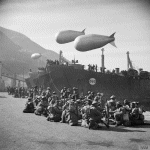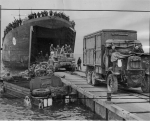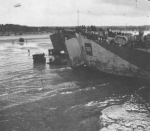NavSource Online: Amphibious Photo Archive
HM LST-368
ex
LST-368

LST-368 was transferred to the United Kingdom for the duration of World War II
Please report any broken links or trouble you might come across to the Webmaster. Please take a moment to let us know so that we can correct any problems and make your visit as enjoyable and as informative as possible.

Royal Navy History Commissioned into the Royal Navy as HM LST-368, 4 January 1943 Sailed from New York for the Mediterranean in convoy UGS6A, 19 March 1943 HM LST-368 participated in the following campaigns: Sicilian occupation Salerno landings West Coast of Italy operations-1944--Anzio-Nettuno advanced landings Invasion of Normandy Operated between France and southern ports of England after the invasion Sailed to India in 1945 and took part in the invasion of Malaya Paid off and returned to US Navy custody at Subic Bay, Philippines, 16 March 1946
| Click On Image For Full Size Image |
Size | Image Description | Source | |
|---|---|---|---|---|

1016040903 |
150k | Chart of Eastern Sicily's coastline, south of Syracuse, showing 6 rows of ships. Many are Liberty ships, e.g., SS Bigfoot Wallace and
SS Mayo Brothers and LSTs,
HM LST-368,
HM LST-413 and
HM LST-409. The LSTs are stationed at D3, E2, and F2 respectively.
The 80th Flotilla of Canadian Landing Craft operated in GEORGE Sector, the bay outlined in black marker in top right corner, home today to a seaside community, Fontane Bianche.
Gordon Harrison wrote "I will visit there in July to recall Dad's service, 80 years ago. I hope to find the cave he lived in w mates for 3 weeks. (His mates in the 81st Flotilla transported troops and supplies in the HOW Sector at Amber, Red and Green beaches right next door to the south, also marked w black outline. Near modern day Gallina). Most details on the map are quite accurate, a few are not (e.g., Avola and Noto are farther south than drawn). I also include a photo from IWM that reveals coastline south of Syracuse, with liberty ships and LSTs in their stations." Gord Harrison, London Ontario Related entry on website - 1000 Men, 1000Stories |
Gordon Harrison | |
 |
100k | South African troops of 1991 Swaziland Smoke Company wait to board HM LST-368 and other landing ships at Castellammare
before sailing for Anzio. The unit was responsible for creating smokescreens over the invasion area.
Imperial War Museum War Office Second World War Official Collection by No. 2 Army Film & Photographic Unit, Radford (Sgt), Photo No.© IWM (NA 11380) |
Mike Green | |
 |
395k | An Albion lorry and Sexton 25 pdr self-propelled gun come ashore from HM LST-368, at Anzio in January, 1944. Note the DUKW
moored alongside the jetty. Imperial War Museum War Office Second World War Official Collection by Radford (Sgt) of the No. 2 Army Film and Photographic Unit, Photo No.© IWM(NA 11392) |
Photo Tommy Trampp Caption Mike Green |
|
 |
90k | HM LST-368 to starboard of HM LST -365 landing equipment and material at Normandy, June 1944. | Robert Hurst | |
| Back To The Navsource Photo Archives Main Page | Back To The Amphibious Ship Type Index | Back To The Tank Landing Ship (LST) Photo Index |
| Comments, Suggestions, E-mail Webmaster. |
|
This page is created by David W. Almond and maintained by Gary P. Priolo |
p>